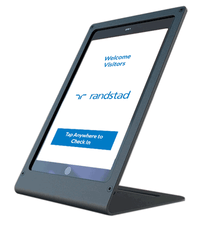Executive Summary
- In almost any workplace, it is imperative to welcome and quickly connect visitors with the right host.
- A variety of white-collar offices and retail environments have adopted client arrival notification systems to facilitate this process.
- In addition to instant reception notifications, key features include the ability to preregister guests, visitor photos and badges, integrations, and data security.
In a modern workplace setting, it is most unprofessional for a client to be kept waiting for long periods of time. Yet in busy professional offices - like law firms, accounting offices, consulting firms, government agencies, marketing and media agencies – meetings and other responsibilities can delay the response. It can be challenging to find an unobtrusive way to notify an employee that their guest has arrived.
Client arrival notification systems do exactly that!
What Is a Client Arrival Notification System?

A client arrival notification system is an automated system designed to inform employees that a client has arrived and is waiting to meet with them. Also known as visitor management systems, these systems allow clients and guests of every nature – from restaurant and parcel delivery to important clients and colleagues – to self-register with your workplace.
The truly beautiful part of these systems is that, once the visitor has checked themselves in, the system performs the automatic task of tracking down the host employee. Instead of a receptionist trying to place a phone call, only to find that a person is in a meeting, a digital system quickly and seamlessly utilizes the employee’s preferred notification methods. Within seconds, the digital check-in system can send notifications via phone, text, email, Slack, Teams, and Google Hangouts Chat.
Who Uses a Client Arrival Notification System?
Nearly any professional office with employees who meet multiple clients for appointments can benefit from a client arrival notification system.
- Financial services firm
- Recruiting firms and staffing agencies
- Federal, state, and local governments
- Accounting and law offices
- Marketing and media agencies
- Consulting firms
- Mental and physical health professionals
- Manufacturing facilities
 In most of these types of offices, professionals alternately meet with colleagues, have appointments with clients, and spend time completing their professional work.
In most of these types of offices, professionals alternately meet with colleagues, have appointments with clients, and spend time completing their professional work.
We all know-how meetings and appointments have a tendency to get off track and sometimes end up running past their allotted time. Given how often this happens, it is important to know whether an employee has an important client waiting in the lobby for their scheduled time. Being notified by a discreet text message or other messages on their phone can provide the employee the information to excuse themselves to meet their client without having a receptionist interrupt the meeting.
On the other hand, when the employee is engaged in important work in the office, the notification that a client has arrived gives them the opportunity to wrap up what they are doing before the client arrives in their office. Depending on office protocol, the employee may choose to meet the client in the lobby and escort them to their office.
Even busy professional offices that employ a receptionist at the front desk may find that a digital system can notify employees in a fraction of the time it takes the receptionist.
- There is no need for the receptionist to remember which employee prefers text over the phone; the digital visitor check in system will do that.
- There is no need to spend precious minutes trying multiple notification methods – or worse, walking away from the client to interrupt a meeting in progress.
- Again, the digital system will contact the employee in the order of their notification preferences.
Not only do these check-in systems assist with notification, but they also have other benefits for professional offices as well.
Provides Confidentiality
Clients do not have to say their names aloud to a receptionist. Instead, they confidentially and discreetly enter their information into the check-in system and then take a seat to await their appointment. This preserves a level of privacy in medical offices, law offices, and other waiting rooms that can’t be managed with an in-person receptionist or a paper visitor log.
Assures Accuracy
When clients enter their own information, as opposed to relaying it for a receptionist to enter into the system – or writing it on a paper form to be re-typed into a database – they can ensure their names are spelled correctly and other information is also accurate. Even if they are a return guest, they can verify the information that is already in the system and make changes if necessary, such as an address update.
Increased Security
Professional offices may not always consider security, but should. Law firms, therapy practices, accounting firms, and other professionals have a strong need to know exactly who is on the premises at all times. Visitor registration systems provide this information.
Accurate Records for Billing Purposes
A professional’s schedule of appointments is often packed solid. What happens if the 3 p.m. appointment never shows? How is a note made so that client is not billed for that appointment? A visitor check-in log can be an important part of the billing process. The log provides the data of record for who came to appointments and thus should be billed.
Key Features of Client Arrival Notification Systems
Client arrival notification systems (a.k.a. visitor management systems) provide many more features than just that of notifying employees of a client’s arrival. While notifications may be a primary reason to consider such a system, there are several other features that may be beneficial to a professional organization.
Preregistration
Most of the time, professionals will know when they have appointments with clients. Some systems allow employees to preregister their guests so the system can recognize them more quickly upon their arrival.
 Collecting signatures
Collecting signatures
In most professional offices, it is necessary to have clients sign important documents at the start of their visit. This can be anything from filling out medical forms and records to non-disclosure agreements, to other waivers and agreements. Some of these agreements are simple and standard, and thus do not require a lengthy explanation by a professional. These documents can be presented as part of the check-in process and completed via the e-signature app capabilities found in many visitor management systems.
Digital visitor logbook
Sometimes it is nearly impossible to know who was on-site at any particular time. However, if there were some sort of security breach, this information can be incredibly important for investigation purposes. Having all guests of any type check in and check out using an app automatically creates a digital visitor logbook that is easy to search.
Visitor Badges
Depending on the size and protocols of the organization, it may be necessary for guests to be identified using some form of visitor badge. Being easily identified can give employees the ability to offer assistance when it is needed. In addition, it can help ensure visitors do not go into places where they should not be.
Visitor Photos
Some visitor management systems have the ability to take visitor photos. This is not only incredibly helpful for security purposes, but it can help employees more quickly attach a name to a face to provide better service. Some systems even send the photo with the notification about a client's arrival so the employee knows exactly who they are looking for. Building relationships is a large part of professional services, and being able to recognize someone on sight shows obvious effort on the part of the professional.
Integrations
Great visitor management systems integrate with your:
- LDAP like Active Directory or G Suite to automate user management
- Calendar for even faster preregistration
- A corporate instant messaging app like Slack, Microsoft Teams, or Google Hangouts Chat for immediate notifications where employees communicate
- Contact Relationship Management (CRM) system for tracking when leads visit your workplace
- Zapier so you can build more automation and custom workflows
What to Look For in a Visitor Check-in System
Understanding what is possible can help an organization evaluate systems to determine which is right for their office and its needs.
- Your brand is the hero: Does the visitor management system allow you to customize the look and feel of the check-in screen? Does it support white labeling, or will the software company’s logo be on all the screens? Great systems will be easy to customize and support your organization’s brand.
- Visitor routing customization: Visitors should be presented with a screen that asks them appropriate questions based on the various reasons why they are visiting. “What is the purpose of your visit?” is a likely starting point, with options to select, like “Making a delivery” to “I have an appointment with an employee.” These options. and the rest of the check-in workflow can be customized according to the type of service an organization offers.
- Easy to use: Any visitor sign-in app should be easy to set up with no technical skills required. Think minutes and not days (or weeks). Not only should the system be simple for the organization to administer, but it should also be intuitive for visitors. Screens should guide visitors through the check-in process with minimum hassle or confusion.
- Equipment needs: Since a check-in kiosk requires dedicated hardware, look for a system that works on commonly available and inexpensive tablet computers. It should not be necessary to buy proprietary hardware equipment to run. This type of equipment is often expensive and especially costly to service or replace.
- Cost: The system you select should be cost-effective for what you want it to do. Most have various levels of service plans depending on the features you want and the number of devices on which you have it installed. Many also have monthly or yearly plans to suit your needs.
- Integration capabilities: The systems being considered should have the ability to integrate with your existing systems. Ask about not only integrating with your CRM but also with your existing LDAP, Active Directory, etc. if your organization uses one.
- Privacy and security features: It is also important to ask about the security features of the system. Given that it can contain private information about your clients, like contact information, ensuring that it is secure is of utmost importance. Review your selected system's data security policy and make sure your data will be encrypted both in transit and at rest. Even better find a solution that demonstrates best-in-class standards like Privacy Shield certification and GDPR compliance.
Summary - Professional Firms Deserve Professional Systems
Professional offices and their clients both benefit from digital client arrival notification systems that speed up the check-in and notification processes of appointments. Everything feels more professional when no one is kept waiting and wondering if the host has been contacted – or vice versa, wondering if your client has arrived but you don’t know it yet.
These visitor management systems provide more benefits than simple notification. With preregistration capabilities, visitor photos, integration with CRMs, legal signatures, and more, the systems have a variety of features to make life at the office flow more smoothly.